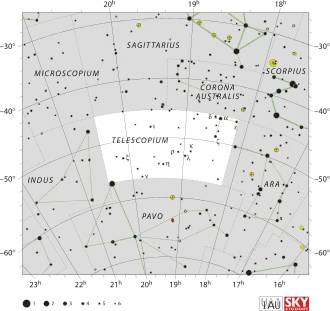Epsilon Telescopii
ε Telescopii (Epsilon Telescopii; kurz ε Tel) ist mit einer scheinbaren Helligkeit von 4,53m der dritthellste Stern des nur vom Südhimmel aus sichtbaren Sternbilds Teleskop.[2] Dennoch erscheint der orangefarben leuchtende Stern dem bloßen Auge relativ lichtschwach. Nach im Dezember 2020 veröffentlichten Auswertungen der Messergebnisse der Raumsonde Gaia ist der Stern etwa 406 Lichtjahre von der Erde entfernt.[1] Er ist wohl ein Einzelstern.[9]
| Stern Epsilon Telescopii | |||||||||||||||
|---|---|---|---|---|---|---|---|---|---|---|---|---|---|---|---|
 | |||||||||||||||
| AladinLite | |||||||||||||||
| Beobachtungsdaten Äquinoktium: J2000.0, Epoche: J2000.0 | |||||||||||||||
| Sternbild | Teleskop | ||||||||||||||
| Rektaszension | 18h 11m 13,76s [1] | ||||||||||||||
| Deklination | -45° 57′ 15,9″ [1] | ||||||||||||||
| Helligkeiten | |||||||||||||||
| Scheinbare Helligkeit | 4,53 mag [2] | ||||||||||||||
| Spektrum und Indices | |||||||||||||||
| B−V-Farbindex | +1,01 [2] | ||||||||||||||
| U−B-Farbindex | +0,78 [2] | ||||||||||||||
| Spektralklasse | K0 III [3] | ||||||||||||||
| Astrometrie | |||||||||||||||
| Radialgeschwindigkeit | (−26.3 ± 0.8) km/s [4] | ||||||||||||||
| Parallaxe | (8.0405 ± 0.3210) mas [1] | ||||||||||||||
| Entfernung | (406 ± 16) Lj (124 ± 5) pc [1] | ||||||||||||||
| Visuelle Absolute Helligkeit Mvis | −1,00 mag [5] | ||||||||||||||
| Eigenbewegung [1] | |||||||||||||||
| Rek.-Anteil: | (−18.837 ± 0.339) mas/a | ||||||||||||||
| Dekl.-Anteil: | (−38.102 ± 0.265) mas/a | ||||||||||||||
| Physikalische Eigenschaften | |||||||||||||||
| Radius | 22 R☉ [6] | ||||||||||||||
| Leuchtkraft | |||||||||||||||
| Effektive Temperatur | (4996 ± 42) K [8] | ||||||||||||||
| Andere Bezeichnungen und Katalogeinträge | |||||||||||||||
| |||||||||||||||
Der Stern hat die Hauptreihe bereits verlassen und ist nun ein Riesenstern der Spektralklasse K0.[3] Er zeigt einen Infrarotexzess, so dass er von einer Staubscheibe umgeben sein dürfte.[10] ε Telescopii besitzt etwa 22 Sonnendurchmesser[6] und seine Oberfläche ist mit einer effektiven Temperatur von knapp 5000 Kelvin[8] etwas kühler als die Sonne. Er hat einen etwa 13,0m hellen optischen Begleiter, der im Jahr 1999 etwa 16,4 Bogensekunden von ihm entfernt stand[11] und wesentlich weiter, nämlich circa 3540 Lichtjahre, von der Erde entfernt ist.[12]
Weblinks
Anmerkungen
- Gaia early data release 3 (Gaia EDR3) für ε Tel, Dezember 2020.
- H. L. Johnson, B. Iriarte, R. I. Mitchell, W. Z. Wisniewskj: UBVRIJKL photometry of the bright stars. In: Communications of the Lunar and Planetary Laboratory. 4, Nr. 1, 1966, S. 99–110. bibcode:1966CoLPL...4...99J. (Datensatz auf VizieR).
- Nancy Houk: Michigan catalogue of two-dimensional spectral types for the HD stars. In: Ann Arbor: Dept. of Astronomy, University of Michigan. 2, 1978. bibcode:1978MSS...C02....0H.
- G. A. Gontcharov: Pulkovo compilation of radial velocities for 35495 Hipparcos stars in a common system. In: Astronomy Letters. 32, Nr. 11, November 2006, S. 759–771. arxiv:1606.08053. bibcode:2006AstL...32..759G. doi:10.1134/S1063773706110065. (Datensatz auf VizieR).
- E. Anderson, Ch. Francis: XHIP: An extended hipparcos compilation. In: Astronomy Letters. 38, Nr. 5, 2012, S. 331–346. arxiv:1108.4971. bibcode:2012AstL...38..331A. doi:10.1134/S1063773712050015. (Datensatz auf VizieR)
- Gaia data release 2 (Gaia DR2) für ε Tel, April 2018
- I. McDonald, A. A. Zijlstra, M. L. Boyer: Fundamental Parameters and Infrared Excesses of Hipparcos Stars. In: Monthly Notices of the Royal Astronomical Society. 427, Nr. 1, November 2012, S. 343–357. arxiv:1208.2037. bibcode:2012MNRAS.427..343M. doi:10.1111/j.1365-2966.2012.21873.x. (Datensatz auf VizieR).
- S. Alves, L. Benamati, N. C. Santos, V. Zh. Adibekyan, S. G. Sousa, G. Israelian, J. R. De Medeiros, C. Lovis, S. Udry: Determination of the spectroscopic stellar parameters for 257 field giant stars. In: Monthly Notices of the Royal Astronomical Society. 448, Nr. 3, April 2015, S. 2749–2765. arxiv:1503.02556. bibcode:2015MNRAS.448.2749A. doi:10.1093/mnras/stv189. Von dieser Arbeit sind hier die T13-Linien-Daten der Tabelle angeführt.
- P. P. Eggleton, A. A. Tokovinin: A catalogue of multiplicity among bright stellar systems. In: Monthly Notices of the Royal Astronomical Society. 389, Nr. 2, September 2008, S. 869–879. arxiv:0806.2878. bibcode:2008MNRAS.389..869E. doi:10.1111/j.1365-2966.2008.13596.x.
- B. Zuckerman, Sungsoo S. Kim, T. Liu: Luminosity Class III Stars with Excess Far-Infrared Emission. In: Astrophysical Journal Letters. 446, Juni 1995, S. L79. bibcode:1995ApJ...446L..79Z. doi:10.1086/187935.
- ε Telescopii im Washington Double Star Catalog.
- Gaia early data release 3 (Gaia EDR3) für ε Tel B, Dezember 2020.